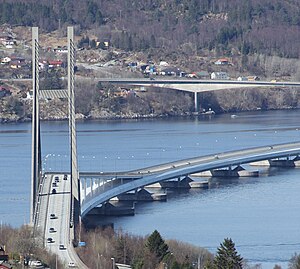
Back كوبرى نوردلاند ARZ Nordhordlandsbroen Danish Nordhordlandsbrua German Ponte di Nordhordland Italian Nordhordlandsbrua NN Nordhordlandsbrua NB Ponte Nordhordland Portuguese Nordhordlandsbron Swedish
Nordhordland Bridge | |
|---|---|
 | |
| Coordinates | 60°31′26″N 05°15′52″E / 60.52389°N 5.26444°E |
| Carries | Two lanes of E39 One pedestrian/bicycle path |
| Crosses | Salhusfjorden |
| Locale | Bergen and Alver, Norway |
| Official name | Nordhordlandsbrua |
| Maintained by | Norwegian Public Roads Administration |
| Characteristics | |
| Material | Concrete |
| Total length | 1,614 m (5,295 ft) |
| Height | 99 m (325 ft) |
| Longest span | 172 m (564 ft) |
| Clearance below | 32 m (105 ft) |
| History | |
| Designer | Aas-Jakobsen |
| Opened | 22 September 1994 |
| Statistics | |
| Daily traffic | 17,487 (2016)[1] |
| Toll | Yes, since 2019. Also 1994–2005. |
| Location | |
 | |
The Nordhordland Bridge (Norwegian: Nordhordlandsbrua) is a combined cable-stayed and pontoon bridge which crosses Salhusfjorden between Klauvaneset (in Bergen Municipality) and the island of Flatøy (in Alver Municipality) in Vestland county, Norway. It is 1,614 meters (5,295 ft) long, of which the pontoon section is 1,246 meters (4,088 ft) long. The cable-stayed section consists of a single 99-meter (325 ft) tall H-pylon which has a length of 368 meters (1,207 ft) and a main span of 172 meters (564 ft). This allows for a clearance of 32 meters (105 ft).
The floating section is a steel box girder bridge with ten pontoons, which because of the fjord's depth are not laterally anchored. The roadway sits on an orthotropic deck. The pontoons and the cable-stayed bridge are built in concrete, with the main span being supported with 48 cables. The fjord end of the main span is supported by a 30-meter (98 ft) deep foundation, where the two bridges meet. From there and for 414 meters (1,358 ft), the roadwall has a 5.7 percent gradient on a viaduct anchored to the pontoon bridge.
The bridge carries two lanes of European Route E39, also called the Coastal Highway, and one pedestrian and bicycle path, and connects the district of Nordhordland to Bergen. Plans for a bridge had existed since the 1960s, and after the decision to construct the bridge was passed by the Parliament of Norway in 1989, construction started in 1991. Total costs, including auxiliary roads, was NOK 910 million. Part of the contract payment was subject to a court case which the contractors lost. The bridge opened on 22 September 1994, and remained a toll road until 31 December 2005. In 2014, it had an average daily traffic of 16,580 vehicles. Tolls were reinstated on the bridge in 2019 to finance other road projects in the area. The bridge is the second-longest in Norway, and the second pontoon bridge in Norway.